MENU
MENU
Tea production area:Murakami City and Sadogashima Island
Brand:Murakami tea and Sado bancha
Type of tea: Sencha (medium-steamed green tea), black tea, hojicha (roasted green tea) and bancha
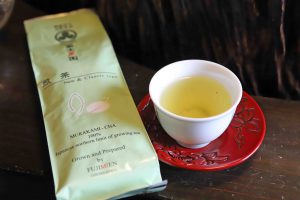
Murakami tea (sencha) of Fujimien and a tea saucer of Murakami tsuishu (lacquerware)(November 2018)
History
Tea is cultivated and produced in Murakami City and Sadogashima Island.
The tea produced in Murakami City is called Murakami tea which has been produced since at around 1620’s which was the beginning of Edo Period. There are 2 theories of the beginning of Murakami tea. One is that Naoyori HORIMICHI, lord of the Murakami Domain brought tea seeds from Edo. The other is that Kakuzaemon TOKUMITSUYA, chief minister of the Murakami Domain brought tea seeds from Uji and Ise.
Sencha and black tea of Murakami tea were exported to the United States and other countries during the Meiji Period, when the tea industry reached its peak.
Snow and tea plants
There are many difficulties of tea cultivation in a snowy country. During the winter.
About 10 to 30% of tea plants in the tea fields are damaged because of the weight of snow every year. The tea plants which are broken or spilt badly are cut, but other damaged plants are waited to be recovered naturally for 2 to 3 years.
Various measurements of protecting tea plants are taken, such as “putting up a pole and tying a nursery plan with stripe to support the tea plants”, “greenhouse cultivation”, “covering tea fields with kanreisha (a black chemical cheesecloth)”, “special pruning to minimize the damage of snow and cold wind”, etc. It is also necessary to decide the timing of scattering fertilizer over the tea fields while considering when it snows.
Snow is troublesome for the tea plants, but it protects from blizzard. The tea plants survived the brutal winter, and then new buds put forth.
The hour of daylight is not long in Murakami City. Thus, the tea leave has low tannin contents and the tea which flavor is less astringency with slight sweetness can be made.
Due to the tea farmers’ efforts and the improvement of cultivation techniques, Murakami tea has been produced for more than 400 years even in a cold region.
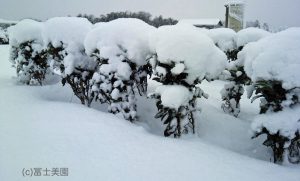
Tea plants are supported with poles and tied with strings (January 2017)
Photo provided by Fujimien http://fujimien.jp
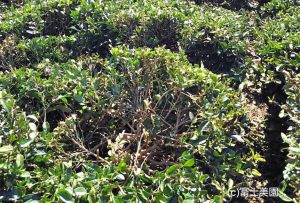
Tea plants damaged by snow (March 2020)
Photo provided by Fujimien http://fujimien.jp
Snow is troublesome for the tea plants, but it protects from blizzard. The tea plants survived the brutal winter, and then new buds put forth.
The hour of daylight is not long in Murakami City. Thus, the tea leave has low tannin contents and the tea which flavor is less astringency with slight sweetness can be made.
Due to the tea farmers’ efforts and the improvement of cultivation techniques, Murakami tea has been produced for more than 400 years even in a cold region.
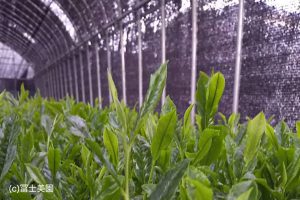
Tea cultivated in a greenhouse (May 2020)
Photo provided by Fujimien http://fujimien.jp
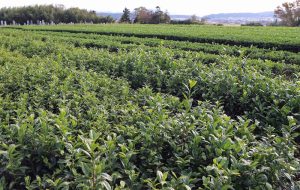
Tea fields of Fujimien (November 2018)
Murakami tea Sommelier course
Murakami City Tourism Association holds Murakami Tea Sommelier course a few times in a year in Murakami City. In the course, participants learn the history of Murakami tea, the method of making a tasty Murakami Tea. After participating the course, the participant can receive a certificate of Murakami Tea Sommelier.
The course was canceled due to the spread of COVID-19.

Murakami Tea Sommelier course (November 2018)
Machiya cafe
There are many machiya (traditional wooden townhouse) in Murakami City. Murakami City retains its historic appearance and there are many machiya left in Murakami City. Some of them are used as tea shops and cafe. Machiya cafe Enya serves Yukiguni kocha (雪国紅茶 black tea of snow country) which is the black tea produced in Murakami City.
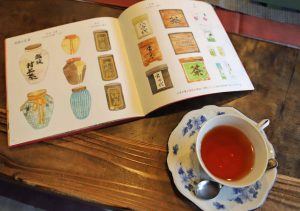
Yukiguni kocha, Machiya cafe Enya (November 2018)
Sado bancha
Sado bancha has been drank and Chagayu (tea porridge) using Sado bancha has been eaten in Sadoagshima Island. The tea is roasted steamed green tea. Tradition says that bancha was introduced when the culture of Kyoto was introduced.
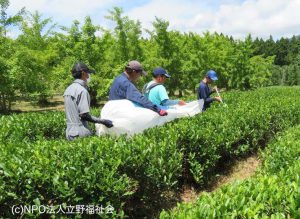
The members of Challenged Tateno are plucking tea leaves (June 2020)
Photo provided by NPO法人立野福祉会 https://tateno-hukusikai.amebaownd.com
Due to the aging and the shortage of successors, the number of tea producers has decreased, while abandoned farmland has increased. On the other hand, a local disability employment training farm Challenged Tateno (NPO Tateno) takes over the abandoned tea fields and cultivates tea. It is an independence support project for the disability. They are producing Sado bancha and biscotti using Sado bancha and selling them.
Tea leaves are plucked between June and August, when the farmers are not busy because of rice cultivation.
Sado bancha has less bitterness but has a good flavor. It is recommended that making chai with strong Sado bancha, milk and sugar.
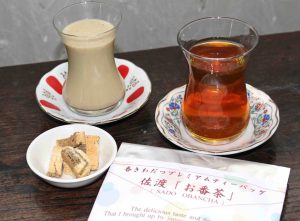
Sadobancha and biscotti using Sadobancha (March 2021)
Niigata Tea Festival (Ocha fes)
Niigata Tea Festival has been held by volunteers who love tea once a year since 2018. In the festival, tea, herbal tea, other products produced in Nigata Prefecture are exhibited in the festival.

Nigata ocha fes in Nigata City (October. 2020)
Photo provided by Nigata ocha fes https://www.ochafes.com
Batabata tea of Itoigawa City
Batabata tea of Asahi Town, Toyama Prefecture is famous. However, Batabata tea has been drank in Itoigawa City too. There are some differences Batabata teas of Itoigawa City and Asahi Town. Asahi Town’s Batabata tea is a post fermented tea. However, Itoigawa City’s Batabata tea is brewing black beans, wild grasses such as Cassia nomame, flowers of tea etc., and whisked them using a special chasen (tea whisk).
Bancha (番茶・晩茶):
Originally bancha means coarse tea in contrast with sencha (medium-steamed green tea). Sencha is produced with new tender tea leaves which plucked in the first tea season in Japan. Bancha is produced with matured hard tea leaves and stems plucked in the late season of the first tea season or in autumn. Shuto bancha means steamed green tea produced with tea leaves plucked in the autumn and early winter.
Additionally, bancha is used for the local special tea, such as Sado bancha of Nigata Prefecture, Mimasaka bancha of Okayama Prefecture, Awa bancha of Tokushima Prefecture, Kyo bancha of Kyoto Prefecture, etc., but each producing method is different.
Related article on the site: 「日本のお茶の生産状況」「お茶の種類 和紅茶 雪国紅茶(日本)」
Tea related facilities:
村上市観光協会 https://www.sake3.com
冨士美園 http://www.fujimien.jp
常盤園 https://maruki-tokiwaen.com
九重園 https://www.kokonoen.com
Tea mascot Yuru-Chara:
Tea related event:
村上茶ムリエ講座 Murakami Tea Sommelier course
新潟お茶フェスティバル Nigata ocha festival https://www.ochafes.com
Ceramic and pottery art: Mumyoi ware
Reference:
松下智 (平成3年) 日本名茶紀行 (初版) 雄山閣出版
高野實、谷本陽蔵、富田勲、中川致之、岩浅潔、寺元益英、山田新市 執筆 (社)日本茶業中央会監修 (2005) 緑茶の事典 改定3版 柴田書店
2020.5.1 市報むらかみP2 村上茶が誕生してから400年目を迎えます
冨士美園 www.fujimien.jp
新潟お茶フェスティバル https://www.ochafes.com
NPO法人立野福祉会チャレンジド立野
https://tateno-hukusikai.amebaownd.com
https://www.facebook.com/challengedtateno/
大森正司、阿南豊正、伊勢村護、加藤みゆき、滝口明子、中村羊一郎編(2017) 茶の事典 初版第一刷 朝倉書店
*When visiting the shops and facilities introduced in this article, please check the business hours on their website, etc. before visiting.
*The information provided on this site may be updated. If you find any information in this article that is incorrect, new, or incomplete, please contact CHAMART.
*The site does not describe all “Teas of Japan” or all “Teas of the World”. Additionally, each article expresses the writer’s personal experience and feelings.
#murakamitea #nigata #teatrip #greentea #tealover #enjoytea #japanesetea